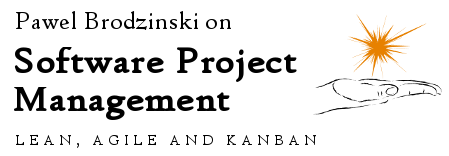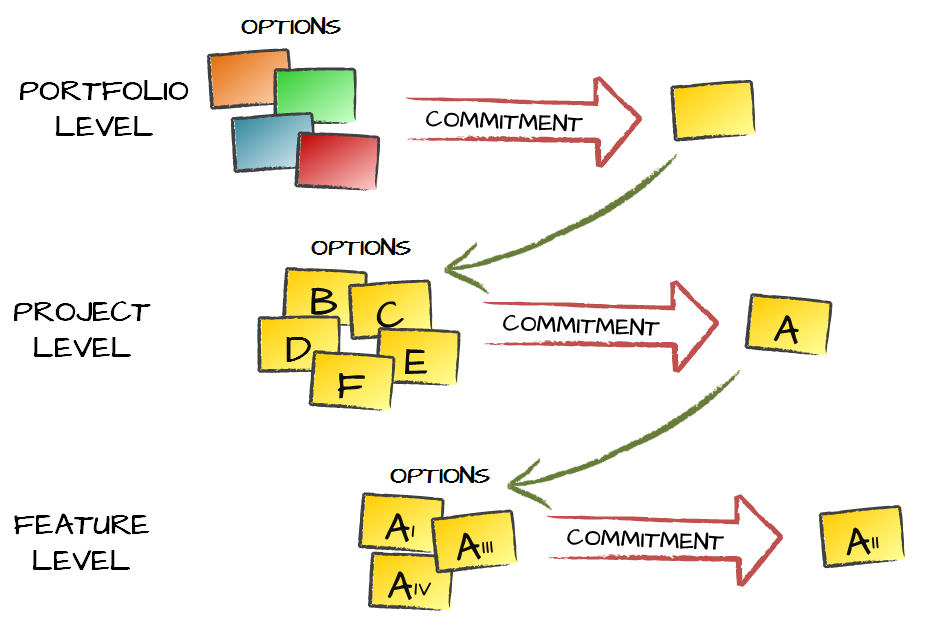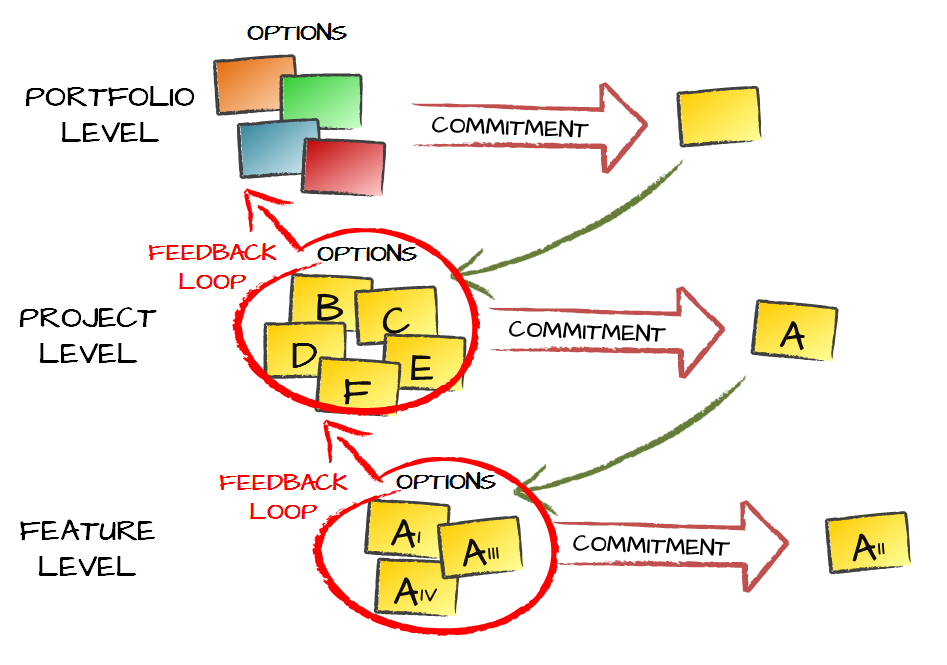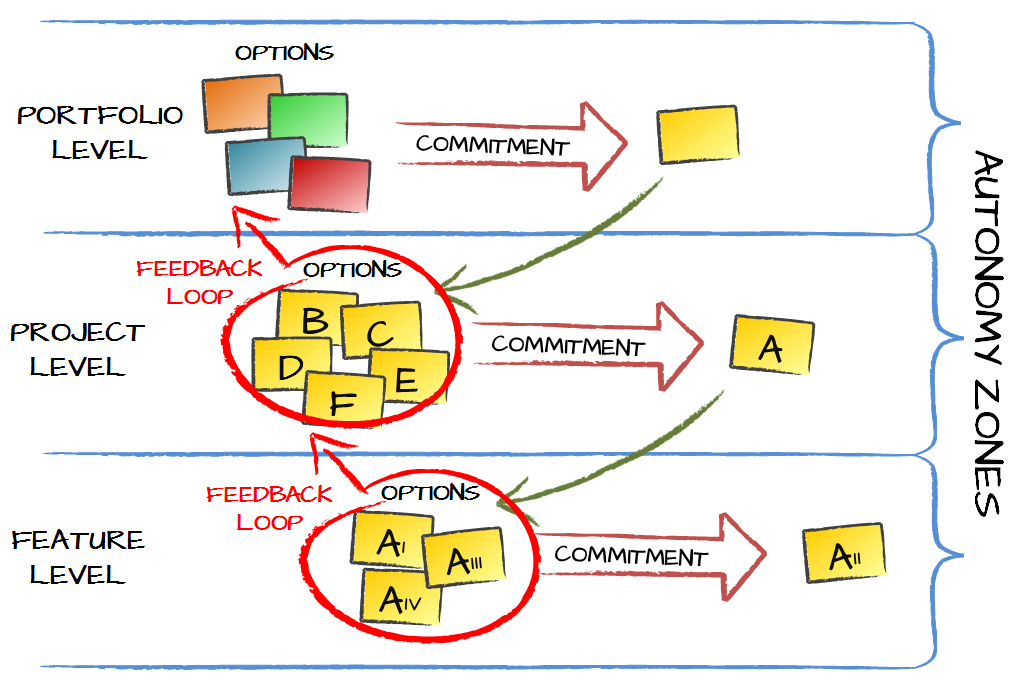I’m a huge fan of Real Options. Along with Cynefin, it is one of the models that can be very universally applied in different domains. No wonder that some time ago I proposed application of Real Options as a sense making mechanism that connects different levels of work being done in an organization.
Simply put, potential work, be it projects or products, are options. We rarely, if ever, can effectively work on all the potential initiatives we have on our plates. That’s why we end up picking, a.k.a. committing to, only a subset of options we have.
Each commitment to start an initiative instantly generates a set of options on a lower level of work. Once we commit to run a project there are so many ways we can structure the work and so many possible feature sets that we can end up building. We again have a set of options available and again eventually commit to execute some of them. That in turn generates the options on a layer or finer granularity work items, say individual features. It goes all the way down to the most atomic work items we have.
We need an accompanying mechanism to close a full feedback loop between the layers of work. We simply need to provide information back to the higher level of work. Think of situations like a project taking longer than expected. We obviously want that information to be taken into account when we are making commitments on a portfolio level. Ultimately, it means that available capabilities have changed and thus it influences the set of options we have on a portfolio level.
Again, the similar dynamics will be seen between any of the two neighboring layers of work. Specific technical choices for features will influence how other features are built or how much time we’d need to make changes in a product.
The model can be easily scaled up to reflect all the layers of work that are present in an organization. In big companies there will be multiple layers of work even in the area of portfolio management only.
The underlying observation is that we very, very rarely need information to be escalated farther than between neighboring levels of work. In other words a single feature that is late will not affect decision-making process on portfolio level. By the same token commitment to start a new project, as long as it takes into account available capabilities, will be of little interest to a feature team involved in an ongoing initiative.
There is, however, one basic assumption that I subconsciously made when proposing this model. The assumption is about autonomy.
Work flows down to the finer-granularity level is through a commitment at a coarser-granularity level. The commitment, however, is not only expressing good will that we want to build something. If we make a commitment to run a project we need to fund and staff it. The part of the commitment is providing people, skills and resources required to accomplish that project within expected constraints, be it time, budget, scope, etc.
If there are other constraints that are important they need to be explicitly described once the commitment is being made. One example that comes to my mind would be around the ultimate goals for a product or a project. It can be about technical constraints – for whatever reasons technologies that a product will be built in may be fixed. Another common case would be about high level dependencies, e.g. between two interconnected systems.
Such constraints need to be explicit and need to be expressed when the commitment is being made simply because they influence what options we will have in the lower level of work.
There’s also another important reason why we want explicit constraints. When we move our perspective to a different level of work we also change the team that is involved in work. In the most common scenario the team context will change from PMO, through a project team to a feature team as we go down through the picture.
And that’s exactly when autonomy kicks in. Commitment on a higher level of work generates options on a lower level. What kind of options we get depends on the constraints we set. These are all prerogatives of a team making decisions on a higher level.
The specific choice among the available options, on the other hand, is responsibility of a team that operates on a lower level.
Obviously, we don’t want PMO leader to tell developers how to write unit tests. That’s the extreme example though and I see violation of autonomy all over the place.
Let’s start from the top. The role of PMO in such a scenario would be to pick initiatives that we want to run, a.k.a. make project- or product-level commitments. The part of the process would be defining relevant constraints for each commitment. These would be things like manning and funding the new initiative, sharing expectations deadlines, etc. This is supposed to provide fair amount of predictability and safety to the team that will be doing the actual work.
One crucial part of defining constraints is making the goals of the initiative explicit. What we are trying to achieve with this product or project. In other words why we decided to invest time of that many people and that much money and we believe it was a good idea.
And now the final part. Then PMO should get out of the way. Options are there in a product team or a project team. That team should have autonomy to pick the ones they believe are the best. Interference from the top will disable autonomy and as such will be a source of demotivation and disengagement. It is very likely that such interference would yield suboptimal choice of options too.
The pattern remains the same when we look at any two neighboring layers of work. For example, we will see similar dynamics between a product team and a feature team.
The influence on which options get executed happens through definition of constraints and not by enforcing a specific choice of options. Those different levels of work are, in a way, isolated between each other by the mechanism of commitment that yields options on a lower level, feedback loops going up and finally by distributing authority and maintaining autonomy to make decisions within own sphere of influence.
Unsurprisingly the latter gets abused fairly commonly, which is exactly why we need to be more aware and mindful about the issue.





 Subscribe RSS feed
Subscribe RSS feed Follow on Twitter
Follow on Twitter Subscribe by email
Subscribe by email



1 comment… add one
Thank you so much for writing this article it’s very helpful for me.
best Project management